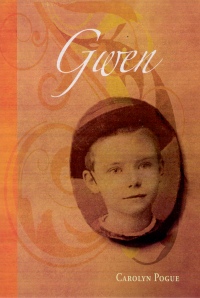| ________________
CM . . . . Volume XVI Number 5. . . .October 2, 2009. 
 |
Gwen.
Carolyn Pogue.
Toronto, ON: Sumach Press, 2009.
157 pp., pbk., $12.95.
ISBN 978-1-894549-80-6.
Grades 6-9 / Ages 10-14.
Review by Brianne Grant.
*/4
|
| |
|

Gwen, by Carolyn Pogue, is a sentimental portrait of home children and early Canadiana. As a piece of historical fiction, this book fails to take a balanced look at the historical content from which it draws.
Gwen is taken to a Girl’s Home after her father dies and a neighbour recommends her to the institution. At the Home, Gwen knows nothing of how to pray, and her journey to learn to behave and become a “good” Christian becomes a main thread of the story. In the beginning, she reveres the natural world and outdoors, but gradually this faith is replaced by her Christian indoctrination. By the end of the book, she thanks or mentions God continuously. This transformation is shown to be natural and correct.
Two girls within the Girl’s Home, Amy and Jean, are taken from the streets in an aggressive manner and recount fearing being taken away. However, while at the school, they adjust well and become good friends. These girls represent the only hint of the controversy the Home Children program has caused. Thousands of past Home Children are still striving to find their families in Britain, with many claiming they were not willing participants, homeless or without family and were wrongfully sent away. These children are not acknowledged in this representation of the Home Child program. While in Canada, Gwen initially stays with an abusive family from whom she runs away. These are godless people who do not attend church, a representation which implies a moral problem with the family rather than representing the many Home Children who ran away from abusive situations because the structure of the program was flawed. Instead, the program is viewed in a positive light as Gwen returns to the Home Child Coordinator in her region and heads to another family. This next family is comfortable and safe, and she stays with them as a family member rather than an indentured labourer.
In school, Gwen faces many difficulties as an outsider. However, she befriends two Mohawk children who take her to their home on a reserve. Pogue does not mention the Mohawk Institute of Brantford, a residential school which took children from the reserves in the area in which the two Aboriginal children reside. Pogue describes the children as having ““black”” eyes rather than brown. Although they are described as smiley and welcoming, the adjective ““black”” itself is rooted in old school narratives about Aboriginal peoples as wild and savage. In speaking of Mohawk writer E Pauline Johnson, a person with whom Gwen is particularly fascinated, her father describes Johnson as “a real Indian princess,” and although this phrase may reflect some people’s language and sentiment at this point in history –– this comes without any criticism or input to make a reader question the nature of the phrase itself. Although Gwen takes a more respectful approach to her discussions of Johnson, her fascination is rooted in an exotic perspective as she describes Johnson moving “wild across that stage.” While it seems as though Pogue would like to write a positive story including Aboriginal people and characters, she fails to use diction that has not historically repressed Aboriginal cultures and further fails to include the socio-political content that adequately addresses –– or even hints at –– the specificity and experience of the Aboriginal children she is writing about.
This lack of specificity is not relegated to the Aboriginal people she depicts. Pierre Paul, a Quebecois man Gwen encounters on the train to reach her new Canadian home, is a classic stereotype. Pierre is a “hairy” lumberjack wearing a red plaid shirt and having a big bushy moustache. He also calls Gwen chérie and feeds her maple syrup. His speech is nearly incomprehensible at times, Pierre “go to Montreal for sometimes and Quebec for sometimes, and for sometimes I go to my baby daughter, married to an anglais.” He “make de travel” and gives Gwen tips about living in the wilderness. Pogue occasionally slips French words into Pierre’s speech, which is much more effective in demonstrating his culture than the “dis, dat, dere” etc in his diction. This representation of Franco-Canadian culture is a mere repetition of the stereotypes that have graced Monty Python skits and other mockeries of Canadian identity.
Expressions like spit spot and I’ll be a monkey’s uncle fill the text but do not create the feeling that this book is representing an older time; they just make the book feel unrelatable. Pogue’s letter to the reader explains that this book was inspired by her own grandmother who was, herself, a Home Child. Her passion for Canadian history is evident in her writing, and I credit her for honouring her family and children who had similar experiences of her grandmother. With more fine-tuning and balance to the historical content, this would have made an important story to tell.
Not recommended.
Brianne Grant is a graduate of the Master of Arts in Children's Literature program at the University of British Columbia and is Executive Councillor-West of IBBY Canada.

To comment on this title or this review, send mail to
cm@umanitoba.ca.
Copyright © the Manitoba Library Association. Reproduction for personal use is permitted only if this copyright notice is maintained. Any other reproduction is prohibited without permission.
NEXT REVIEW |
TABLE OF CONTENTS FOR THIS ISSUE- October 2, 2009.
AUTHORS |
TITLES |
MEDIA REVIEWS |
PROFILES |
BACK ISSUES |
SEARCH |
CMARCHIVE |
HOME |
